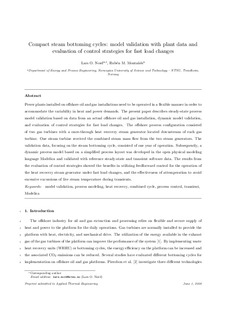| dc.contributor.author | Nord, Lars O. | |
| dc.contributor.author | Mocholí Montañés, Rubén | |
| dc.date.accessioned | 2018-07-10T05:37:13Z | |
| dc.date.available | 2018-07-10T05:37:13Z | |
| dc.date.created | 2018-07-09T09:51:43Z | |
| dc.date.issued | 2018 | |
| dc.identifier.citation | Applied Thermal Engineering. 2018, 142 334-345. | nb_NO |
| dc.identifier.issn | 1359-4311 | |
| dc.identifier.uri | http://hdl.handle.net/11250/2504868 | |
| dc.description.abstract | Power plants installed on offshore oil and gas installations need to be operated in a flexible manner in order to accommodate the variability in heat and power demands. The present paper describes steady-state process model validation based on data from an actual offshore oil and gas installation, dynamic model validation, and evaluation of control strategies for fast load changes. The offshore process configuration consisted of two gas turbines with a once-through heat recovery steam generator located downstream of each gas turbine. One steam turbine received the combined steam mass flow from the two steam generators. The validation data, focusing on the steam bottoming cycle, consisted of one year of operation. Subsequently, a dynamic process model based on a simplified process layout was developed in the open physical modeling language Modelica and validated with reference steady-state and transient software data. The results from the evaluation of control strategies showed the benefits in utilizing feedforward control for the operation of the heat recovery steam generator under fast load changes, and the effectiveness of attemperation to avoid excessive excursions of live steam temperature during transients. | nb_NO |
| dc.language.iso | eng | nb_NO |
| dc.publisher | Elsevier | nb_NO |
| dc.rights | Attribution-NonCommercial-NoDerivatives 4.0 Internasjonal | * |
| dc.rights.uri | http://creativecommons.org/licenses/by-nc-nd/4.0/deed.no | * |
| dc.title | Compact steam bottoming cycles: model validation with plant data and evaluation of control strategies for fast load changes | nb_NO |
| dc.type | Journal article | nb_NO |
| dc.type | Peer reviewed | nb_NO |
| dc.description.version | acceptedVersion | nb_NO |
| dc.source.pagenumber | 334-345 | nb_NO |
| dc.source.volume | 142 | nb_NO |
| dc.source.journal | Applied Thermal Engineering | nb_NO |
| dc.identifier.doi | 10.1016/j.applthermaleng.2018.07.012 | |
| dc.identifier.cristin | 1596303 | |
| dc.description.localcode | © 2018. This is the authors’ accepted and refereed manuscript to the article. Locked until 4.7.2020 due to copyright restrictions. This manuscript version is made available under the CC-BY-NC-ND 4.0 license http://creativecommons.org/licenses/by-nc-nd/4.0/ | nb_NO |
| cristin.unitcode | 194,64,25,0 | |
| cristin.unitname | Institutt for energi- og prosessteknikk | |
| cristin.ispublished | true | |
| cristin.fulltext | postprint | |
| cristin.qualitycode | 1 | |

